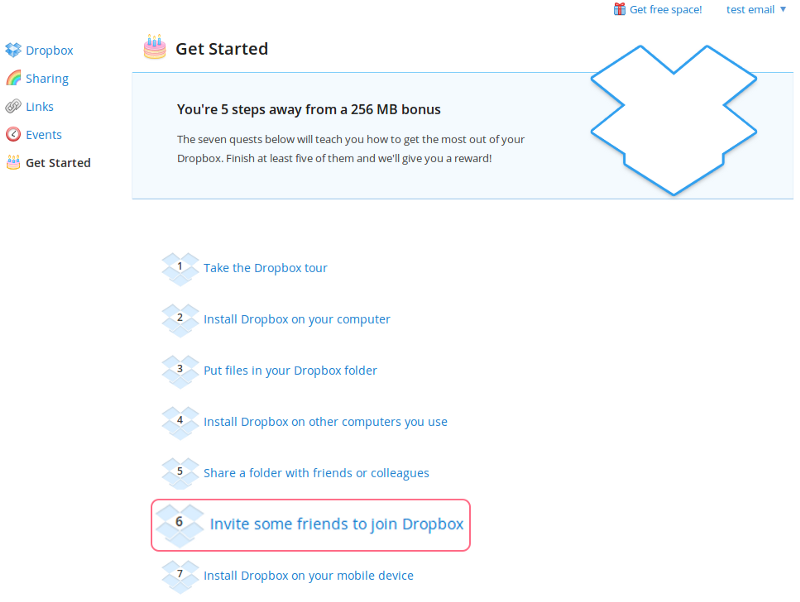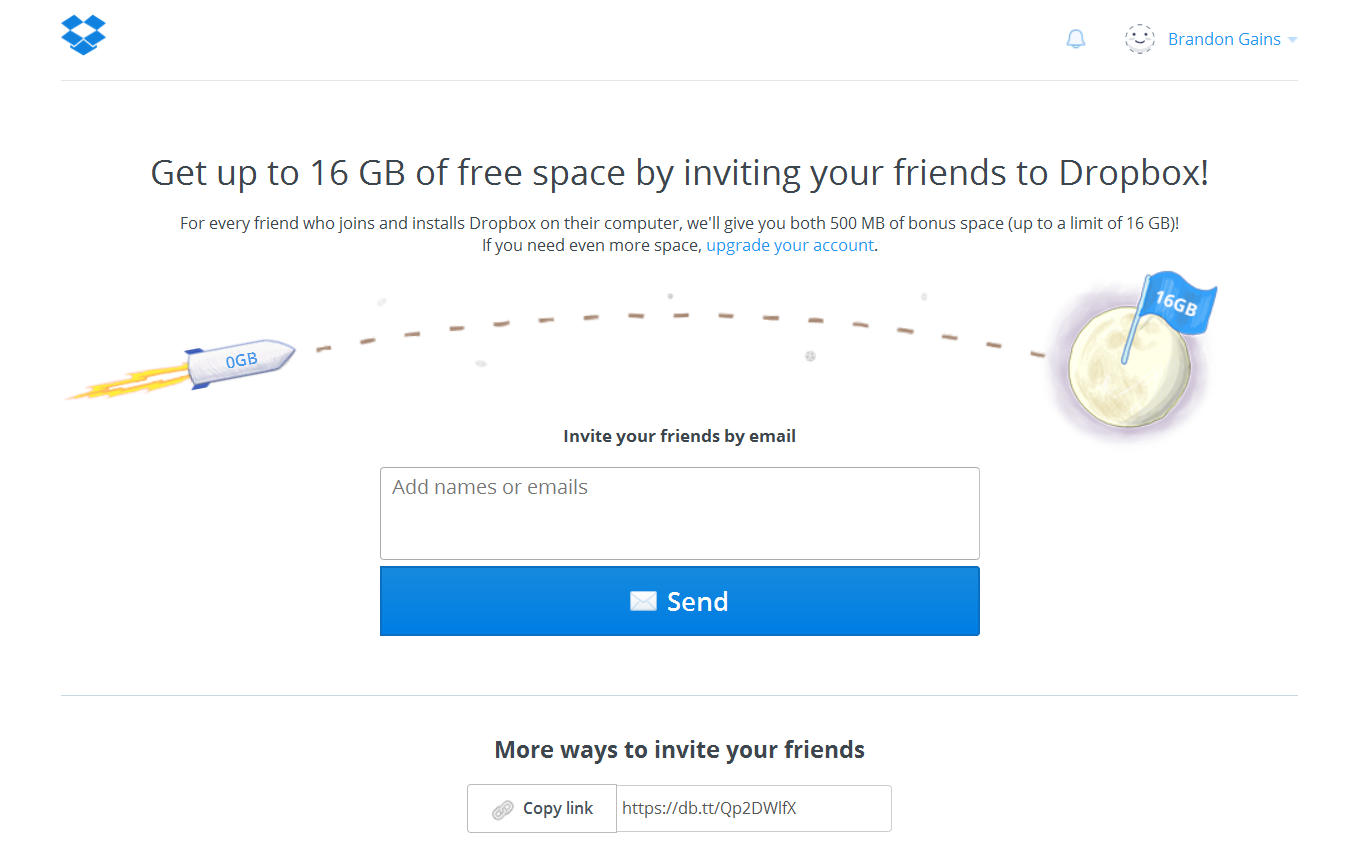Put your growth on autopilot
GrowSurf is modern referral program software that helps product and marketing teams launch an in-product customer referral program in days, not weeks. Start your free trial today.
Tech startups are always looking for ways to get more users. They don't just want traffic. They want quality traffic that will help them build a strong customer base
One of the best things you can do to increase your conversion rate is referral marketing!
Thanks to its referral program, Dropbox increased its conversion rates by a staggering 3900%. This viral growth is a prime example of the power of referral marketing when executed effectively. By incentivizing existing users to share Dropbox with their networks, the company was able to rapidly acquire new customers at a very low cost.
In this post, we'll break down how they did it so you can reap the same benefits with your own company.
Only a few people know that Paypal was the inspiration behind the Dropbox massively successful referral program.
Before PayPal became the leading digital payments platform, it used to reward referrals with cash. The company spent a whopping $60 million on referral incentives, paying early adopters $20 for signing up and another $20 bounty for every new user they referred. This aggressive referral strategy paid off, as PayPal experienced 7-10% daily growth and grew its user base to over 100 million members.
Sounds impressive, right?
Before we dive deep into the inner workings of the Dropbox referral program, let's first look at some important numbers:
Dropbox had a user base of just 100,000 by September 2008, a relatively modest growth considering how competitive the tech marketplace was at that time. Major players like Microsoft were also planning to launch similar cloud storage products, making it challenging for the young startup to gain traction.
But between 2008 and 2010, the company's user base started to double every three months, resulting in 2.8M invites sent in April 2010.
The company went from 100k registered users to 4M registered users. That's a 3900% growth over 15 months!
No wonder the referral program is one of the most studied referral programs in the history of referral marketing.
By 2017, just 9 years after launching their referral program, Dropbox had amassed nearly 34 million users. To put their meteoric growth into perspective, the company reached a $10 billion valuation and over $1 billion in annual revenue that same year. This demonstrates the immense potential of referral marketing to drive rapid user acquisition and revenue growth for businesses.
Looking at a Slideshare presentation by Drew Houston, the co-founder and CEO of Dropbox, one surprising detail comes up:
At the time when the company experienced its most significant growth, it was mostly staffed by engineers, not marketing gurus.
By now, you must be wondering:
How did these guys pull it off?
In fact, the Dropbox referral program was quite simple: reward people with more free space for referring to their friends but also for accepting an invitation.
Their incentive was cleverly designed as a double-sided reward: both the referrer and the referred friend would get 500 MB of free storage space. Every successful referral earned both parties an additional 500 MB, up to a generous limit of 16 GB for the referrer. This double-sided incentive helped create a viral loop by motivating both existing users to share Dropbox and new users to become advocates themselves after experiencing the value.
But here's something else that might interest you:
The company did more than just pick a suitable referral program incentive.
They did a few more things that influenced the success of the referral program, which is:
One of the keys to Dropbox's referral program success was promoting it at the optimal time - when users were most engaged with the product. Research shows that customers are much more likely to participate in a referral program when it's promoted during a high-engagement touchpoint like onboarding or a purchase. This allows brands to leverage the existing goodwill and excitement around their product.
And what a better time than when the customer is engaged in onboarding your product or service.
That's exactly what Dropbox did with its referral program. In addition to filling out basic details and getting tips on using the product, Dropbox cleverly integrated its referral program into the onboarding process as the final step. This ensured that every new user was made aware of the program and given an easy opportunity to share Dropbox with their network right after signing up.
They employed a fundamental marketing principle: the more visible and accessible a referral program is, the higher the participation rates will be. By putting their program front-and-center during onboarding, Dropbox ensured maximum visibility when users were most primed to share.

A common pitfall many referral programs face is unclear or confusing messaging around program details and rewards. If the terms are ambiguous or users make incorrect assumptions, it can lead to frustration, distrust, and high dropout rates. Dropbox avoided this by keeping their referral messaging crystal clear.
Dropbox nailed the referral program's messaging with a clear, straightforward explanation of how it worked:
"Refer a friend, and Dropbox will give you 500MB of free storage space if that friend installs Dropbox on their computer. Your friend will also get the same 500MB storage bonus. There's a limit of 16GB total free space you can earn through referrals."
This transparent, easy-to-understand overview eliminated any potential confusion around the program's double-sided incentive structure and reward limits.

Reducing friction is crucial for driving referral program participation. Research shows that even minor barriers like having to navigate across multiple pages can lead to frustration and dropoff. Dropbox wisely streamlined the referral experience by allowing users to share from the same page they landed on after signing up.
People are inherently put off by cumbersome processes. A good referral program removes as many hurdles as possible, making it effortless for customers to refer friends and colleagues. Dropbox achieved this by consolidating the entire share flow into a single step.
Dropbox nailed the low-friction referral experience by offering a single page with multiple easy sharing options:
By consolidating everything onto one page and providing multiple frictionless paths to refer, Dropbox eliminated any unnecessary hurdles that could hamper participation.
Because Dropbox offered users the option to sync their contact lists directly from email providers like Yahoo, Gmail, and AOL. This allowed advocates to quickly share en masse with their entire network without having to manually enter each contact one-by-one, drastically reducing the effort required.

By providing full transparency into referral statuses and rewards earned, users stayed informed and engaged throughout the entire process. This level of clear communication helps set proper expectations and prevents frustrations that could lead to drop-off.
Through their account dashboard, referrers could see at a glance:
This level of insight allowed advocates to track progress towards program milestones and take follow-up actions like sending reminders to friends who hadn't signed up yet.
Keeping track of how their referrals performed motivated users to follow up with their network and send more referrals to maximize their free storage earnings. This gamification element of working towards a concrete reward tapped into people's innate desire for achievement and progression. The transparency into referral statuses allowed advocates to optimize their outreach and identify opportunities to re-engage friends who hadn't signed up yet.

The final brilliant touch that supercharged Dropbox's referral program was their strategic use of email to create a viral loop and sustain momentum. Here's how it worked:
Here's how it worked:
This simple yet powerful email flow helped Dropbox consistently re-engage advocates when they were most primed to share, maximizing referral value.
While Dropbox's referral program was undoubtedly brilliant in its strategic design and execution, it's not an unattainable outlier. Many of the key principles that drove its success, like incentive design, low-friction experiences, and nurturing viral loops, can be adapted by businesses across industries.
The core takeaway is that referral marketing, when thoughtfully implemented, can be an incredibly powerful growth engine. By leveraging existing customer enthusiasm and incentivizing word-of-mouth sharing, companies can cost-effectively acquire new customers through authentic recommendations from trusted sources.
While Dropbox's results were exceptional, you too can potentially drive a high referral program ROI by following some key best practices:
By nailing incentives, product-market fit, and customer experience, any company can leverage referrals to cost-effectively acquire new customers through authentic word-of-mouth.

GrowSurf is modern referral program software that helps product and marketing teams launch an in-product customer referral program in days, not weeks. Start your free trial today.
Word-of-mouth marketing reigns supreme when it comes to growth and increasing sales. According to the Word of Mouth Marketing Association (WOMMA), there are more than 2.4 billion brand-related conversations everyday in the United States.
We break down exactly how Bench Accounting's B2B referral program succeeds with purpose-driven marketing and choosing the perfect referral incentives.
One good way to create a successful referral program is to look at how other people did it. Case in point: Morning Brew. Want to learn how they built an audience of 2.5 million? This blog post breaks down the Morning Brew referral program in detail!